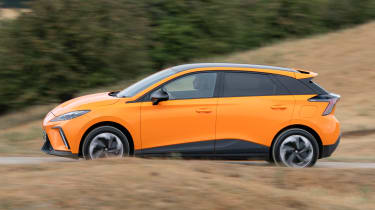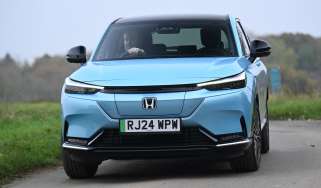MG4 Trophy Long Range 2022 review
Our first drive of the new MG4 proves that the brand finally has what it needs to take on the big boys, thanks to decent driving manners and a good range for a very keen price

Verdict
MG’s first bespoke EV, the MG4, is a definite hit. It offers plenty of technology in a modern-looking package that rolls solid practicality into the mix. The real surprise is how the MG4 blends dynamics that are sharp enough to offer a little driving fun, with comfort that makes it usable in every situation, and impressive efficiency that delivers genuinely usable real-world range. Factor in good charging speeds and the incredible affordability, and the MG4 shouldn’t be overlooked.
This is British brand MG’s ‘ID.’ moment. While the Chinese-owned firm has dabbled with EVs in the past – including the impressive affordable ZS crossover and MG5 estate – this MG4 family hatchback is where the company’s push with its next generation of models really begins. That’s why, in almost every sense, you can see parallels with Volkswagen’s ID.3 – hence this being a crucial car for MG.
For a start, both models are competing in the same sector and aiming for the same buyers: everyone from city dwellers to families who might use the MG4 as a second car, as well as company car drivers keen to cut their Benefit-in-Kind tax bill.
There are even more similarities when you analyse the key figures. The MG4 EV is based on an all-new platform for the brand, called MSP, which stands for Modular Scalable Platform. Like the ID.3, it employs a rear-mounted motor producing 200bhp, which is fed by a 64kWh battery in this top-spec Trophy Long Range version for a claimed range of 270 miles. Opt for the more affordable SE Long Range and this increases to 281 miles. Meanwhile, all MG4s have 150kW rapid charging, so a 10-80 per cent top-up for the bigger battery takes 35 minutes. Use a 7kW home wallbox and it’ll take nine hours to fully replenish.
Used - available now
As with the VW, there’s also a smaller- battery model – simply badged SE – that uses a 51kWh pack and claims up to 218 miles between charges. It’s a different story with prices, though. Even for our range-topping model you’ll pay just £31,495.
By comparison, the ID.3 line-up currently starts at £36,195 and just one spec is offered: the 58kWh Pro Performance model in Life trim, with a claimed 264-mile range.
It’s not like the MG scrimps on kit given the price, either. All trim levels have a 10.25-inch touchscreen infotainment system with sat-nav, Apple CarPlay and Android Auto. There are plenty of EV-specific features, too, such as charging station info, energy readouts and adjustable modes for the powertrain and brake regeneration.
There’s also a 360-degree camera and parking sensors, wireless phone charging, climate control, plenty of driver-assistance tech, 17-inch alloy wheels, LED headlights, heated front seats, a heated steering wheel and vehicle-to-load charging to power external devices.
The sat-nav is similar to a Google-based set-up, so it’s intuitive and the traffic info seemed accurate during our test. However, the responses sometimes seemed a little hit and miss, and some of the on-screen toggles are small, so it can be hard to adjust functions. At least there are physical shortcut keys for the main options – including one to access the on-screen climate controls – below the main panel.
That panel is joined by a seven-inch digital instrument display, which offers pretty much all the information you need, although we couldn’t find a full-screen map setting, which is a shame.
Sitting in the driver’s seat, it’s clear that MG has premium aspirations and has looked to some German brands for inspiration; the indicator stalks are very similar to Audi’s, for example, while the steering wheel’s rounded-hexagon shape is more than a little reminiscent of the BMW iX’s. Imitation is the sincerest form of flattery, or so they say.
However, while the cabin design looks modern and fairly minimalist, with a jutting ledge for the gear selector that leaves a big open storage space below, the material quality could be better in places. A lot of the plastics that cover the lower dash and doors are rock solid, so although they might be hard-wearing, they don’t feel especially nice. It’s clear that it’s here where you pay the price for, well, the low price, even if the dash-top trim is soft and a few flashes of fake leather break up the plastic.
Thankfully, that’s not true on the move, because the car is a convincing dynamic performer. The motor delivers linear acceleration, with MG claiming 7.7 seconds for the 0-60mph dash. It doesn’t feel that fast, but around town there’s certainly enough flexibility and even sufficient grunt on the motorway to overtake with ease.
What’s arguably more important for an EV is the brake regeneration. The MG4 has four modes: Low, Medium, Strong and Adaptive. We tried all but found the Strong setting to be the best, offering enough regeneration that you don’t need to touch the brake pedal 90 per cent of the time. Full one-pedal driving isn’t possible, but at least brake feel is good, with no jerks or stutters when you have to use the left pedal.
It’s clear the focus here is on comfort, because the MG serves up a soft, flowing ride that means it’s forgiving and comfortable around town, just as it is on country roads and motorways. However, in the latter two situations the higher speeds mean the car sometimes moves around a little more than we’d like, and it takes a bit of guiding to keep it on track.
There’s a surprisingly dynamic edge to the chassis to accompany the relatively refined ride, too. The steering is quick and nicely weighted in Sport mode (Normal is slightly lighter, while Eco mode dulls everything down for maximum efficiency, and an Individual setting saves your favourite parameters). The MG’s front axle can actually keep up with the speed of the steering, so it darts through corners. It’s not so much a B-road blaster, but this agility is definitely useful around town.
Refinement on the move could be a little better, because there’s some noticeable road noise at higher speed, but it’s not a major drawback or a dealbreaker.
There are plenty of other positive areas for the MG, too, including practicality. The new platform’s packaging is impressive and there’s a good amount of rear legroom. It does mean a slight compromise when it comes to boot space, because at 363 litres it’s 22 litres down on its main rival from VW – and the ID.3 isn’t exactly the largest EV in this respect. But the MG’s boot is practical, even if you might test its carrying capacity more than in some other cars.
Visibility is also good, and with the rear-mounted electric motor allowing for a good steering lock, the car’s turning circle is tight, which should help parking and manoeuvring in tight spots.
It’s this breadth of ability and well rounded personality that makes the MG4 such an appealing EV at this price, and it’s compounded by genuine efficiency, not just impressive claims. The MG4 returned 4.2 miles per kWh during our time with it. This means, based on a usable battery capacity of 61.7kWh, it would have returned 259 miles from a charge; that’s within four per cent of MG’s claim without any real concession to hypermiling.
Overall, the MG4 is a convincing EV, and if the brand’s finance offers are good, it’ll be even more impressive. It’s a car that should be on many EV buyers’ shortlists.
| Model: | MG4 Trophy EV Long Range |
| Price: | £31,495 |
| Powertrain: | 64kWh battery/1x e-motor |
| Power/torque: | 200bhp/250Nm |
| Transmission: | Single-speed automatic, rear-wheel drive |
| 0-60mph: | 7.7 seconds |
| Top speed: | 100mph |
| Range: | 270 mile |
| Charging: | 150kW (10-80% 35mins) |
| On sale: | Now |


















